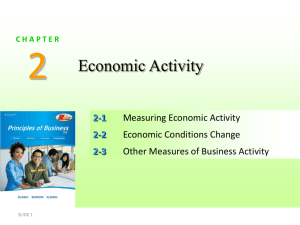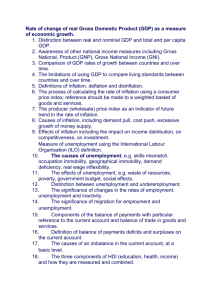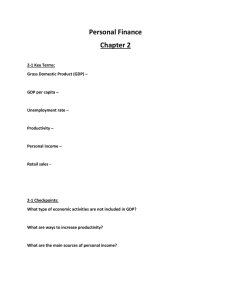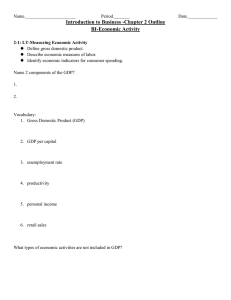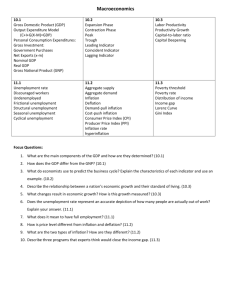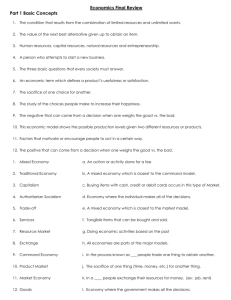Economic Activity
advertisement
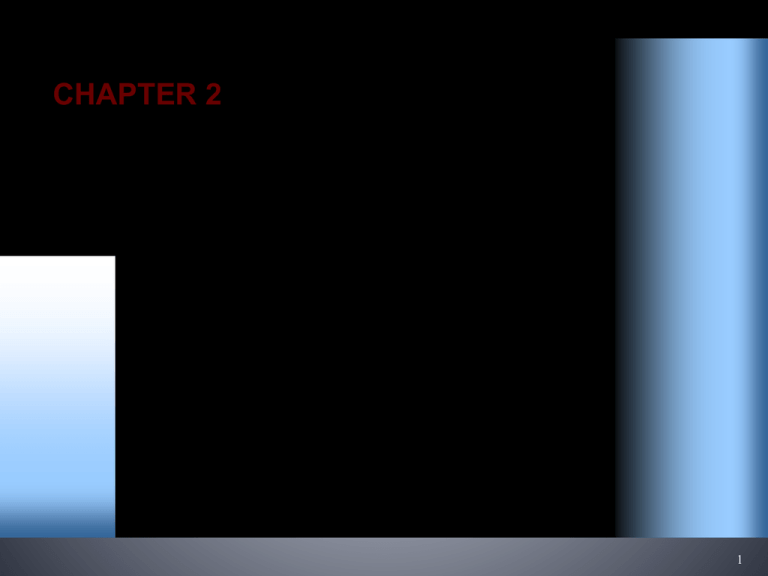
CHAPTER 2 2-1 2-2 2-3 Measuring Economic Activity Economic Conditions Change Other Measures of Business Activity 1 2-1 Goals 11. Define gross domestic product. 12. Describe economic measures of labor. 13. Identify economic indicators for consumer spending. 2 Gross Domestic Product (GDP) GDP per capita unemployment rate productivity personal income retail sales Chapter 2 3 Components of GDP Consumer spending Business spending Government spending Exports minus imports of a country ▪ Only FINAL GOODS count Comparing GDP Output per person GDP divided by the total population Chapter 2 4 Source: CIA World Factbook Chapter 2 5 Checkpoint >> What types of economic activities are not included in GDP? Answer GDP only applies to reported final goods and services. Money earned for goods or services that are not reported would not be included. Goods and services used in the manufacture of other products are only counted once—in the final product. Chapter 2 6 Employment – Labor force consists of all people above age 16 who are actively working or seeking work Unemployment rate- portion of people in the labor force who are not working Productivity – production output in relation to a unit of input OR Output ÷ Input = PRODUCTIVITY What can influence a country’s PRODUCTIVITY? Chapter 2 7 Productivity >> What influences a country’s productivity? Answer Capital resources (equipment and technology) Worker training and Management techniques Safety/security Education level Political stability Chapter 2 8 Personal income – Salary or Wages Investment income Government payments Retail sales – Sales of durable and nondurable goods bought by consumers Retail sales are an indicator of general consumer spending patterns in the economy Main Items: ▪ Automobiles, building materials, furniture, gasoline, clothing, restaurant sales, department stores, food stores and drug stores. Chapter 2 9 Checkpoint >> What are the main sources of personal income? Answer Sources of personal income include wages, salaries, investment income, and government payments. Chapter 2 10 Chapter 2-1 Page 37 ▪ 1-3 and 4 or 5 Chapter 2 11 2-2 Goals 14. Describe the four phases of the business cycle. 15. Explain causes of inflation and deflation. 16. Identify the importance of interest rates. 12 business cycle prosperity recession depression Chapter 2 recovery inflation price index deflation 13 Prosperity Recession Depression Recovery Chapter 2 14 People who want to work are working. Production of G&S hit record highs. Wages are up. Rate of GDP growth increases. Demand for G&S is high. Cannot last forever… why? Chapter 2 15 Demand begins to decrease. Businesses lower production. Unemployment begins to rise. GDP growth slows to 2 or more quarters of the year. Severity varies. Chapter 2 16 When recession grows and spread throughout the nation. Prolonged unemployment Weak sales due to low demand Business failures GDP falls rapidly Chapter 2 17 Unemployment begins to decrease. Demand begins to increase. GDP begins to rise again. Consumers regain confidence in their futures and begin spending again. Chapter 2 18 Checkpoint >> What are the four phases of the business cycle? Answer The four phases of the business cycle are prosperity, recession, depression, and recovery. http://www.wgal.com/money/29191773/detail.html Chapter 2 19 Inflation- 1950’s last 70 yrs Sustained increase in the general level of prices for G&S Buying power of the dollar decreases Causes of inflation When demand is greater than supply Wages may increase but at a much slower rate If wages would go up faster than prices, businesses would need to hire fewer workers, which would worsen unemployment Chapter 2 20 Measuring Inflation Rate of increase fluctuates and has throughout our nation’s history. CPI (Consumer Price Index) ▪ Compares prices in one year with prices in some earlier base year ▪ Can be deceiving because it’s based on a group of selected items and may not reflect necessities such as food, gas, and health care. Chapter 2 21 Deflation Opposite of inflation~ A sustained decrease in the general level of prices for G&S Usually occurs during recessions and depressions Prices are lower but consumers have less money to buy them. Doesn’t include items such as computers whose prices have decrease drastically over the years…Why? Chapter 2 22 Interest Rates Cost of money Individuals, companies, and governments who borrow money are affected by interest rates People with poor credit ratings pay more (higher interest rates) than people with good credit ratings… Why? When borrowing increases, interest rates rise Types of interest rates (continued on next slide) Chapter 2 23 Types of Interest Rates Prime rate- given to banks’ best customers Discount rate- charges to banks by the FED T-bill rate- yield on short- term US gov. obligations (ex. 5 year) Treasury bond rate- yield on long-term US gov obligation (ex. 30 year) Mortgage rate- interest on a home loan Corporate bond rate- large US corporations’ cost to borrow Certificate of deposit rate- rate for long-term deposits at savings institutions Chapter 2 24 ▪ Discount Rate ▪ http://money.cnn.com/2010/02/18/news/economy/discount.rate.fortune/index.htm ▪ Car Loan Rates ▪ Auto Rates ▪ http://www.bankrate.com/finance/auto/auto-loan-rates.aspx ▪ Mortgage Rates (Adjustable Rate Mortgages vs. Fixed Rate Mortgages) ▪ http://mortgage-x.com/trends.htm ▪ Savings Account Interest Rate ▪ CD Rates ▪ http://www.bankrate.com/cd.aspx ▪ http://www.ratestracker.com/historical-cd-rates/ ▪ Credit Card Rates ▪ http://www.indexcreditcards.com/credit-card-rates-monitor/ Chapter 2 25 Checkpoint >> What are the main causes of inflation? Answer Inflation is an increase in the general level of prices that occurs when the demand for goods and services is greater than supply. Chapter 2 26 Checkpoint >> How do interest rates affect business activities in our economy? Answer Interest rates can encourage or discourage borrowing and spending. Lower interest rates allow consumers greater spending power, which increases demand, productivity, and employment. Businesses often pass on the cost of higher interest rates to consumers. Chapter 2 27 Chapter 2-2 Page 42 ▪ 1-3, and choose 4 or 5 Chapter 2 28 2-3 Goals 17. Discuss investment activities that promote economic growth. 18. Explain borrowing activities by government, business, and consumers. 19. Describe future concerns of economic growth. 29 Capital projects- spending by businesses for items such as land, buildings, equipment, and new products. This $ comes from three main sources: Personal savings http://www.bankrate.com/compare-rates.aspx Stock investments Bonds http://www.youtube.com/watch?v=sjyWxERgGJs http://www.bloomberg.com/markets/rates/index.html http://www.investinginbonds.com/learnmore.asp?catid=9 Chapter 2 30 Savings Low risk / low yield option Stock High risk / potentially high yield ownership in a corporation Bond Low risk / mid yield represents debt for an organization and YOU are the creditor Chapter 2 31 Government budget surplus ▪ Gov’t spent less than it took in ▪ Gov’t may reduce taxes or increase spending on various programs Government budget deficit ▪ Gov’t spent more than it took in ▪ Over time this amount builds up… cummulative National debt ▪ Total amount owed by the Federal Government Chapter 2 32 Personal income tax ▪ 20-30% of earned income (latest figures state a rate of 38%) ▪ Collected on a pay-as-you-earn basis ▪ Federal, state, and local Property tax ▪ Based on appraisals of land and property ▪ Local tax Sales tax ▪ Taken at time of purchase ▪ State tax ▪ PA sales tax is 6% ▪ Sin tax- A tax on certain items, such as cigarettes and alcohol, that are regarded as neither necessities nor luxuries. ▪ Excise taxes- taxes paid when purchases are made on a specific good- Often included in the price of the product. Also placed on some activities, such as on wagering or on highway usage by trucks. Chapter 2 33 Most common forms: Loans Bonds Mortgages Poor debt management results in company failure Chapter 2 34 Most common: Credit cards Auto loans Mortgages Pros: Convenient Great for emergencies Cons: Overuse Overspending Chapter 2 35 Checkpoint >> Name some examples of capital projects. Answer Capital projects include the purchase of any item a business will use over an extended period of time such as land, buildings, and equipment. Chapter 2 36 Checkpoint >> What is the cause of a budget deficit? Answer A budget deficit occurs when a government or organization spends more than it takes in. Chapter 2 37 Limited access to health care Need for proper housing for many people Traffic and crime Unemployment Housing market Chapter 2 38 What economic challenges do countries face in the future? Answer Future economic concerns for any country include the ability to increase its output and provide a means for its citizens to meet the basic needs of food and shelter, adequate health care, education, transportation, employment, and safety. Chapter 2 39 To be done by Wednesday: Page 47 ▪ 1 , 2 and 3 or 4 To be done by date of Test (Friday 9/21): Pages 48-51 ▪ 1-30 ▪ Extra Credit: Choose up to two (2) from 31-44 Chapter 2 40
